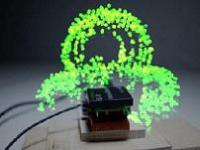Hi,
I think right now seems to be a good point for me to chime in.
In my last project I played a bit around with LED pixels (HL1806 LED strips) connected to the XMOS LED tile solution. The very first beginning of the solution is a bit documented in my HL1606 project. The whole thing still waits for completion & complete documentation. Last project was about 3000 pixels. But I think we can go up to about the double amount per XC-2 board. But thanks to X Link we are not really limited to have only one XMOS chips ;)
I also want to try to get pixel displays with better driver chips (WS2801 seems now the best solution to get in prefabricated pixels eg. in strips and single pixels).
But this form factor seems to be a very nice package for a real huge display.
In the mean time I also got a quite good understanding of the LED tile code, so that I positively recommend it as pixel driver.
So if you are looking for someone who can help to get the LED matrix up & running I am pretty happy to help.
But first of all: How big should the 3D Led Matrix get? Dimension & pixels?
Marcus
Anyone wanna join? customize software
-
Interactive_Matter

- XCore Addict
- Posts: 216
- Joined: Wed Feb 10, 2010 10:26 am
-
xhacktly

- Member
- Posts: 11
- Joined: Thu May 05, 2011 9:45 am
Hi Marcus:D nice to have u on the team;)Interactive_Matter wrote:Hi,
I think right now seems to be a good point for me to chime in.
In my last project I played a bit around with LED pixels (HL1806 LED strips) connected to the XMOS LED tile solution. The very first beginning of the solution is a bit documented in my HL1606 project. The whole thing still waits for completion & complete documentation. Last project was about 3000 pixels. But I think we can go up to about the double amount per XC-2 board. But thanks to X Link we are not really limited to have only one XMOS chips ;)
I also want to try to get pixel displays with better driver chips (WS2801 seems now the best solution to get in prefabricated pixels eg. in strips and single pixels).
But this form factor seems to be a very nice package for a real huge display.
In the mean time I also got a quite good understanding of the LED tile code, so that I positively recommend it as pixel driver.
So if you are looking for someone who can help to get the LED matrix up & running I am pretty happy to help.
But first of all: How big should the 3D Led Matrix get? Dimension & pixels?
Marcus
very cool to see LED strips with motion;) thumbs up!
yes good idea to use the pixel driver.
how big the LED cube should be?, hmm good question.. well i think 8x8x8 or maybe 5x5x5 should hold at the start? what do u guys think? but under 5x5x5 then it might become a bit to small? http://www.youtube.com/watch?v=6mXM-oGggrM
-X
-
franksanderdo

- Experienced Member
- Posts: 69
- Joined: Sat Apr 30, 2011 6:19 pm
Hi folks,
@ Marcus
Welcome to the club 8-)
@all
The cube size is some thing really frightening me.
Why? Pretty easy:
After some reading about xkinect and similar solutions I believe a 3D "camera" with 128 * 128 * 128 resolution can be build and affordable.
This leads to a (not affordable) max. cube of 2.1 million LEDs :o
Back to some thing realistic :lol:
I believe we should start with some thing small like 5 * 5 * 5
If we design it the right way it can be extended any time ;)
See you around
Frank
@ Marcus
Welcome to the club 8-)
@all
The cube size is some thing really frightening me.
Why? Pretty easy:
After some reading about xkinect and similar solutions I believe a 3D "camera" with 128 * 128 * 128 resolution can be build and affordable.
This leads to a (not affordable) max. cube of 2.1 million LEDs :o
Back to some thing realistic :lol:
I believe we should start with some thing small like 5 * 5 * 5
If we design it the right way it can be extended any time ;)
See you around
Frank
-
xhacktly

- Member
- Posts: 11
- Joined: Thu May 05, 2011 9:45 am
franksanderdo wrote:Hi folks,
@ Marcus
Welcome to the club 8-)
@all
The cube size is some thing really frightening me.
Why? Pretty easy:
After some reading about xkinect and similar solutions I believe a 3D "camera" with 128 * 128 * 128 resolution can be build and affordable.
This leads to a (not affordable) max. cube of 2.1 million LEDs :o
Back to some thing realistic :lol:
I believe we should start with some thing small like 5 * 5 * 5
If we design it the right way it can be extended any time ;)
See you around
Frank
i have done some more research and it seems that 12x12x12 wold be best. but ofc then we need many leds so it might also work with 5x5x5 but im not sure.
-
franksanderdo

- Experienced Member
- Posts: 69
- Joined: Sat Apr 30, 2011 6:19 pm
Hey Guys,
12 * 12 * 12 technically would look great.
I am a bit worried about the amount of LEDs and the related current.
Maybe Marcus can help us there a little?
It might be a good Idea to plan the Cube part as flexible as possible ;)
So the user can define the cube based on his savings account :lol:
sorry I am of for a couple of days as I am moving at the moment.
See you around soon
Frank
12 * 12 * 12 technically would look great.
I am a bit worried about the amount of LEDs and the related current.
Maybe Marcus can help us there a little?
It might be a good Idea to plan the Cube part as flexible as possible ;)
So the user can define the cube based on his savings account :lol:
sorry I am of for a couple of days as I am moving at the moment.
See you around soon
Frank
-
Interactive_Matter

- XCore Addict
- Posts: 216
- Joined: Wed Feb 10, 2010 10:26 am
Yes he can ;) - at least he thinks so ;)
I am not concerned by the current - since it will be bad.
12*12*12 would be 1728 LEDs. If we go for RGB which makes sense it is 5148 single color LEDs.
This is quite a number but not so bad.
To reduce flicker we should drive 12*12 LEDs at a time - this is 144 RGB LEDs and 432 single Color LEDs, ending up with a current of about 8,64A if we assume to use 20mA or 21A if we use 50mA. So quite reasonable.
I think a 5V power supply wont do it. But if we use 12 step down circuits it gets reasonable again - ~072A per step down circuit if we aim for 50mA.
I have tried to use PWM encoding or similar for such an amount of LEDs. It is doable but for a real good color rendering we need at least 12bit of resolution to adapt to the logarithmic nature of human perception (twice the brightness is just +1 in the perceived brightness) - this all gets a bit complicated since the brightness level of a LED and the current is not really linear - but this will be solved with a look up table anyway.
But lucky enough there are chips like the TLC5940/5941 or MBI5030/5031 which have 16 channels of output - so we need 27 of those to drive the 432 single color LEDs.
If we are lucky we can cram the whole solution in a single XC-2 kit and drive the display over ethernet. I do not think that we got enough processing power to also drive the kinect with the same XMOS processor. But there is still the beagle board which runs linux so that we can directly use the open source kinect drivers (I hope they are ported/portable to ARM).
So this would be a solution - what do you think? Or should we go directly to 16^3 ;)
Marcus
I am not concerned by the current - since it will be bad.
12*12*12 would be 1728 LEDs. If we go for RGB which makes sense it is 5148 single color LEDs.
This is quite a number but not so bad.
To reduce flicker we should drive 12*12 LEDs at a time - this is 144 RGB LEDs and 432 single Color LEDs, ending up with a current of about 8,64A if we assume to use 20mA or 21A if we use 50mA. So quite reasonable.
I think a 5V power supply wont do it. But if we use 12 step down circuits it gets reasonable again - ~072A per step down circuit if we aim for 50mA.
I have tried to use PWM encoding or similar for such an amount of LEDs. It is doable but for a real good color rendering we need at least 12bit of resolution to adapt to the logarithmic nature of human perception (twice the brightness is just +1 in the perceived brightness) - this all gets a bit complicated since the brightness level of a LED and the current is not really linear - but this will be solved with a look up table anyway.
But lucky enough there are chips like the TLC5940/5941 or MBI5030/5031 which have 16 channels of output - so we need 27 of those to drive the 432 single color LEDs.
If we are lucky we can cram the whole solution in a single XC-2 kit and drive the display over ethernet. I do not think that we got enough processing power to also drive the kinect with the same XMOS processor. But there is still the beagle board which runs linux so that we can directly use the open source kinect drivers (I hope they are ported/portable to ARM).
So this would be a solution - what do you think? Or should we go directly to 16^3 ;)
Marcus
-
Skeksis

- Active Member
- Posts: 61
- Joined: Sat May 28, 2011 9:42 pm
- Location: England
I was thinking about the poor resolution these LED cubes have, would it be feasible to combine an LED matrix with a POV display. That would give depth to the POV and create the illusion of a much larger image, providing the angle of the LEDs and the timing is correct we should be able to create a passable holographic image with depth.
What are everyone's thoughts?
What are everyone's thoughts?
"Time is an illusion. Lunch-time doubly so." - Douglas Adams
-
Interactive_Matter

- XCore Addict
- Posts: 216
- Joined: Wed Feb 10, 2010 10:26 am
This is a great idea! But how to transfer the huge amount of data to a rotating display (I think rotation is the only good motion to realize the POV)? I think wireless is not an option - or is it?Skeksis wrote:I was thinking about the poor resolution these LED cubes have, would it be feasible to combine an LED matrix with a POV display. That would give depth to the POV and create the illusion of a much larger image, providing the angle of the LEDs and the timing is correct we should be able to create a passable holographic image with depth.
What are everyone's thoughts?
Marcus
-
Skeksis

- Active Member
- Posts: 61
- Joined: Sat May 28, 2011 9:42 pm
- Location: England
I'd go with your idea of using ethernet, data transfer rates should be high enough to allow for updating a large number of pixels with RGB data pretty quickly.
Two issues I can see straight off the bat are a) timing and b) vibrations.
Both could be made less of an issue if we have a double-sided LED matrix, so two cubes spinning together attached along one side to a central axle. This should create a gyroscopic affect neutralising a lot of vibration-jitter, see below for what I had in mind.
Two issues I can see straight off the bat are a) timing and b) vibrations.
Both could be made less of an issue if we have a double-sided LED matrix, so two cubes spinning together attached along one side to a central axle. This should create a gyroscopic affect neutralising a lot of vibration-jitter, see below for what I had in mind.
You do not have the required permissions to view the files attached to this post.
"Time is an illusion. Lunch-time doubly so." - Douglas Adams
-
Skeksis

- Active Member
- Posts: 61
- Joined: Sat May 28, 2011 9:42 pm
- Location: England
Really two cubes would be overkill, a couple of rectangles would do for a pretty good resolution, we'd end up with a nice cylindrical hologram. Cortana anyone? :P
"Time is an illusion. Lunch-time doubly so." - Douglas Adams
